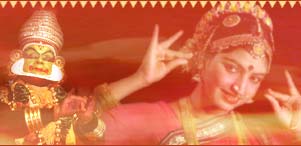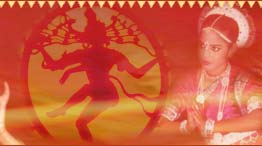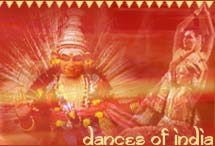Bharatnatyam is one of the ancient classical dances of India which are all based on 'Natya Shastra' originated from Tamil Nadu. Today, it is recognized as the national dance of India. It is believed that this dance form is mainly the renewal of Cathir, an old art of temple dancers. It has been named after Bharat Muni, author of the bible of classical Indian dance called 'Natya Shastra'. The word 'Bharatnatyam' is composed of the terms, 'Bhava' which means expression, 'Raga' which stands for melody, 'Tala' which means rhythm and 'Natya' is for dance. In other words this dance form is a communion of expression, melody and rhythm. The dance is accompanied by the classical Carnatic music. It has emerged as an offering to gods in temples in South India. The dance is famous for its delicacy and perfection of movements which makes it vibrant and influential. This dance form is not only popular in India but is also admired in abroad. In short, Bharatnatyam is an attempt to represent the divine beauty, magic, rhythms and symbols that are present in heaven. Today, it has become an integral part of a girl's upbringing in southern part of India.
History and Evolution
Bharatnatyam is also known as the fifth Vedaor Natya Veda, a quintessence of four Vedas. In the ancient times, it was performed by Devadasis (women who were devoted to serve the deity as dancers and musicians forming part of the rituals) in the temples of Tamil Nadu known as 'dasiattam'. The postures of the celestial dancers depicted in the scriptures were given the name of Bharatnatyam Mudras on earth. About 150 years ago it was codified by four brothers (Chinniah, Sivanandam, Ponniah and Vadivelu) together known as 'Tanjore Quartet'. The various forms of the dance, like Alarippu, Jathiswaram, Sabdham, Varnam and Tillana, were also introduced by them. The main repositories of this art form until the early 20th century were the performers of Isai Velalar caste and the gurus known as 'nattuvanars'. Later, leading personalities such as Rukmini Devi Arundale and E Krishna Iyer made their insignificant contributions.
Significance of Bharatnatyam
The philosophy behind this dance is to search the human soul and unite with the Supreme Being. This dance form enhances its beauty with the use of literary masterpieces of saints and sages. Nowadays this dance form has changed a lot. Contemporary classical Indian dance is performed by both, male and female. At present it is learned as a hobby or a career by many people. Bharatnatyam dance forms are also used to present various themes such as unity of religions, nationalism, purity of environment, greatness of a king, etc.
Attire and Makeup
While the dance itself is absolutely appealing and enigmatic, what makes it all the more compelling is the traditional dress and a touch of makeup. Outfit for female dancers is made from bright colored Kanjivaram silk sari which is of two types; the pajama-style costume comprising of blouse, pajama and two or four fan-shaped pieces overlapping each other at the waist, with a big one ending at ankles. Another one is half-sari which has a blouse, dupatta and a pleated skirt. Male dancers wear a pajama or dhoti and at times a scarf wrapped around their shoulders tucked in front into a belt, made of Kanjivaram silk cloth. These attires look very elegant and enhance the grace of dance movements.
Makeup adds more beauty to the performance. For Bharatnatyam, there is a specific style of makeup which is followed by and large. Initially, a base of pinkish tone is applied with cheekbones highlighted by blush-on to avoid dullness. The eyes are outlined with thick black kohl pencil extended at both ends. A dash of mascara is added to make the eyes more expressive and attractive. A round red or maroon bindi is applied on the forehead as the third eye. Generally, a darker shade of red or maroon lipstick is applied with same color of lip liner. Alta (red color liquid used to color your feet and palms) is applied on the tip of fingers and in the middle of palm and toes to make the fingers attactive and expressive. Dancers also wear jewelry of gold in order to empower their act.
Postures
There are three main elements of Bharatnatyam namely:




